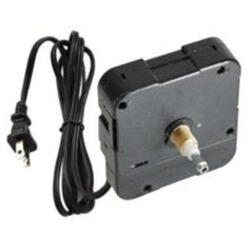+1 888 123 4567

The Worth of High Torque Clock Movements
But high torque clock movements are nevertheless vital as well as extremely valued, because otherwise the bigger clocks wouldn't function in all. Consequentially, these large variations expend electrical power at a faster price than regular ones, requiring an adjustment of batteries a little bit extra regularly, or maybe making use of a C-cell battery instead of the normal AA battery. Electrical power is a measure of electric work and includes voltage increased by current.
For clocks, the voltage is evaluated 1.5 volts, the amount provided by the significant batteries. Thus, to attain a certain degree of torque, or job capacity, requires a matching level of present, translating basically directly right into battery lifespan. Margins for makers are restricted sufficient that they can not manage to enhance clock electric motor work ability for every single conceivable dimension, which makes up a wide range.
Neither can they take the one-size-fits-all technique, as most of the moment this would overkill it. Their concession is to generate one size for many and also one dimension for whatever larger. In our situation, torque is a pressure that causes a clock hand to increase angularly; the amount of energy transfer represents work. The crucial factor is the mass of the minute hand, which is always the longer as well as consequently the heavier things that has to be revolved.
There may be slight variations in hand density (as well as mass), yet resistances are such that all minute hands much shorter than 7 inches can be turned by the requirement (regular torque) motor. Even heavier materials used to build hands, such as steel or brass, loss within these tolerances. Normally, one can get away with hands above seven inches in size if the product is much less thick such as tin or light weight aluminum. Note that optimizing power to the job (i.e., enhancing torque to hand mass) seems to be even more of an issue for modern-day electronic clock movements than it was for the standard mechanically run ones.
The mechanical pressure was a hanging weight or coiled spring, as well as the torque acquired went into rotating a relatively heavy flywheel together with a collection of interlacing gears. The force was adequate, as well as actually it had to be managed with a pendulum as well as an escapement to keep from fleing easily. Modern movements don't need to bother with equipment networks, as all of the ratio estimations are carried out in software program.
This indicates that the called for torque can be much smaller-scale than for mechanical clocks, as well as instead of having to wind a coil or reset the setting of a weight, you simply have to change the battery occasionally. Electronic clock motors frequently do greater than simply tell time according to a schedule that resets every twelve hours. There are several ways to prolong the timekeeping cycle (to 24 hours, say, or to a week, and even to a month), occasionally requiring one more hand, and alternate screens that show moisture, temperature level, tide level, or barometric pressure.
Matching dials need to be selected for every one of these alternatives, with appropriate calibration, though additional torque is seldom necessary, as diameters are reasonably sized. Even so, it is excellent to know how extensive is the range of performance available from parts vendors. You can almost obtain lost in the variety of choices, but never forget the worth of high torque clock movements.
clock hands